Site Contents
Home
Salmon Fishing Scotland
Salmon - Where to Fish
Salmon Fishing Tackle
Salmon Fishing Tactics
Salmon Flies
Trout Fishing Scotland
Trout- Where to Fish
Trout Fishing Tackle
Trout Fishing Tactics
Trout Flies
Sea Trout Fishing Scotland
Sea Trout - Where to Fish
Sea Trout Tackle
Sea Trout Tactics
Sea Trout Flies
Fishing Maps of Scotland
Fishing Articles
Fly Tying
Fishing Photographs
Book of Flies
Fishing Diary
Where to Stay
Fishing Clubs
Fishing Tackle Shops
Fly Fishing Knots
Fishing Weather
Fishing Books
Salmon Recipes
Flies Online
Links
Sitemap
|
Brief Guide to Salmon Fishing Tackle
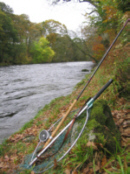 Atlantic
salmon, although they cease to feed on entering our rivers, may be
caught on fly, spinner or on bait. Spin fishing tackle, however, is
generally now reserved for conditions of high water or for times and
places when fly fishing might be impossible. Natural bait fishing for
salmon, with prawns, shrimps and worms for example, has become less
popular in recent years - largely due to the difficulty of returning
fish which have taken a bait - and is, in fact, banned as a method of
fishing on many salmon rivers. At times, the man skilled in the use of
spinning tackle might outfish the fly fisher but, increasingly, wherever and
whenever possible, fly fishing is the favoured option for the majority
of salmon anglers on the majority of our Scottish rivers. Atlantic
salmon, although they cease to feed on entering our rivers, may be
caught on fly, spinner or on bait. Spin fishing tackle, however, is
generally now reserved for conditions of high water or for times and
places when fly fishing might be impossible. Natural bait fishing for
salmon, with prawns, shrimps and worms for example, has become less
popular in recent years - largely due to the difficulty of returning
fish which have taken a bait - and is, in fact, banned as a method of
fishing on many salmon rivers. At times, the man skilled in the use of
spinning tackle might outfish the fly fisher but, increasingly, wherever and
whenever possible, fly fishing is the favoured option for the majority
of salmon anglers on the majority of our Scottish rivers.
Salmon Fly Fishing Tackle
Salmon Fly Rods
Salmon fly rods have come a long way from the heavy and
unwieldy greenheart and split cane rods and horsehair lines
of yesteryear. Today's salmon fly fisher can fish
comfortably for a full day with one of the many modern light
and efficient carbon rods, matched to the latest profile in
specially designed "Spey" lines. On the larger rivers, a rod
of eighteen feet, in the hands of an expert, can cast a fly
more than fifty yards. The more popular length of fifteen
feet, though, will cover most situations allowing thirty
yard casts with relative ease. On the smaller rivers, or in
the low water of summer, shorter double handed rods of
twelve or thirteen feet, or even single handed rods of about
ten feet, will allow a more delicate presentation of the
smaller flies aimed at summer grilse and salmon. Today's
tackle trade caters well for the salmon fly fisher, offering
a wide range of models, from the famous traditional makers
like Hardy and Bruce and Walker; from Daiwa and Shakespeare;
and, now, from companies like Sage, Loomis, Orvis and
Loop, all vying to make their mark in this now very
competitive market.
Salmon Fly Rods
|
|
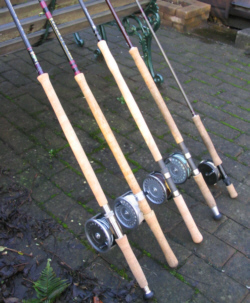 |
Salmon Fly Reels
As with salmon fly rods, the
salmon fisher is faced with a bewildering choice of reels, from the
solid British tradition of a fine old Young's or Hardy fly reel, now
highly regarded by both collectors and fishermen, and much sought after
on the second hand market, to the miracles of modern disc drag
technology, a Loop or an Orvis or perhaps an Abel or a new Hardy disc
drag reel.
For me, the dependable efficiency
of a traditional, well engineered spring and pawl fly reel is hard to
beat, a reel such as the Young's 1500 series or the matchless quality of
one of the older Hardy fly reels - a Hardy Perfect or a Number 1,
2 or 3 Marquis, a St Andrew or, for lighter lines, a Zenith or St Aidan.
With an adequate supply of backing, any of them will cope with all
eventualities likely to be met in salmon fishing on Scottish rivers.
Salmon
Fly Lines
For much of the last century, salmon fly lines meant
supple braided lines of dressed silk which required a great
deal of care if they were to function well. Given proper
attention, however, a silk line was extremely versatile and
the salmon fisherman could fish a whole season with just the
one silk line. The more expensive lines were double tapered
and could be fished, ungreased, as a slow sinking line;
partially greased as a sink tip line; or fully greased as a
floating line, the method popularised by A.H.E. Wood of
Cairnton on the Aberdeenshire Dee as "the greased line"
method of salmon fly fishing. The modern salmon fisherman
spends little time in fly line maintenance and preparation.
Instead, he has a plastic coated fly line for every
conceivable situation. He has floating lines, sink tip
lines, neutral and intermediate lines, slow sinking, medium
sinking, fast sinking, even ultra fast sinking lines; he has
double tapered lines, weight forward lines, shooting heads
and now "Spey" lines with head lengths and profiles to suit
all abilities, styles and preferences; he has tapered
monofilament leaders, braided leaders, poly leaders in all
manner of lengths and densities...... and all this to make
the life of the salmon fly fisherman simpler! As for the
flies.....see
salmon flies |
Salmon Fly Reels
|
|
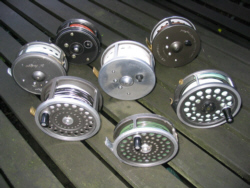 |
|
|
|
|
Salmon Spinning Rods
|
|
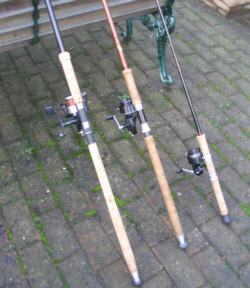 |
|
|
|
|
Salmon Spinning Reels
|
|
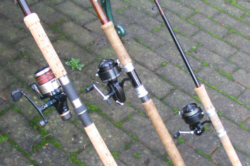 |
|
|
|
|
Salmon Multiplier Reel
|
|
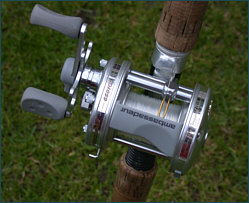 |
|
|
|
|
Devon Minnows
|
|
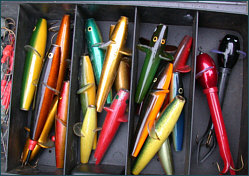 |
|
|
|
|
Salmon Plugs
|
|
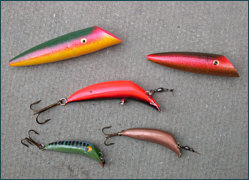 |
|
|
|
|
Mepps spoons
|
|
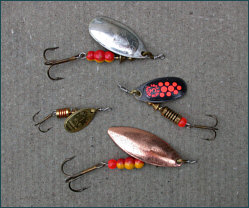 |
|
|
|
|
Salmon Spinners
|
|
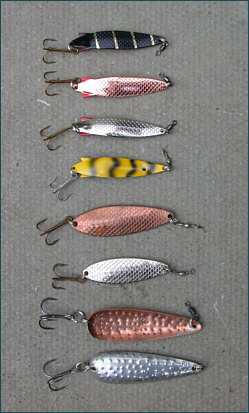 |
|

|
Salmon Spinning Tackle
Salmon Spinning Rods
It is rare now to see a
spinning rod of any material other than carbon on a salmon river. While
these are generally very light and efficient, some seem very stiff and
poker-like, not really an improvement on the more supple cane and
fibreglass they have replaced, a misjudgement on the part of the
manufacturers, I am sure, rather than an inherent unsuitability in the
material itself. The preferred length of spinning rod will depend on the
nature of the river. A small overgrown stream might demand a rod as
short as seven feet, used to cast a small Mepps spoon between the
overhanging branches, while the major rivers will require a more
powerful rod of nine, ten or eleven feet, able to cast the heavier lures
distances of fifty yards or more across the wide streams and pools of
the Tay or Tweed, always assuming, of course, that spinning is permitted
as a legitimate angling method. An ever increasing number of beats on
Scottish salmon rivers are now designated "fly only", irrespective of
conditions or season.
Salmon Spinning Reels
Before the invention of the
modern fixed spool spinning reel and nylon monofilament line, salmon
spinning was done with silk lines on centrepin reels like the Hardy
Silex or Alcock's Aerial and casting a bait or spinner on these old
centrepins was a practised art. Today, life is much simpler for the
newcomer to salmon spinning. Using a modern multi-ball-bearing fixed
spool reel, he can quickly master the rudiments of casting and spin
fishing. Some salmon anglers, however, particularly those fishing in the
spring on the larger rivers, where long casting with heavy nylon and
large spoons is the norm, prefer the multiplier, something like an Abu
6000, which allows more direct contact and better control over a hooked
fish than the fixed spool.
Salmon Spinning
Lures
The salmon spinning enthusiast
has a great array of spinning lures at his disposal. As with salmon
flies, his choice might be dictated, to an extent, by the fashion of the
times. At one time, there seemed nothing to beat the good old Devon
Minnow, which has accounted for thousands of salmon, as has the Abu
Toby. These lures still have there devotees and they still, in the right
hands, catch their share of fish but the preferred options, for the
moment at least, on most salmon rivers would appear to be the Rapala
plug or the Flying C, available in a wide range of weights, sizes and
colours. Other options, all very effective on their day, might include
the Kynoch Killer, Blair Spoon, Canadian Wiggler, Tadpole, Mepps spoons
in various shapes, sizes and colours...... the list of possibilities is
endless.
|